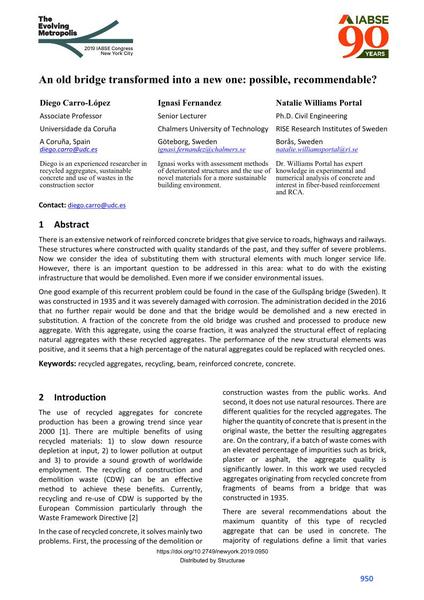An old bridge transformed into a new one: possible, recommendable?

|
|
|||||||||||
Détails bibliographiques
| Auteur(s): |
Diego Carro-López
(Universidade da Coruña)
Ignasi Fernandez (Chalmers University of Technology) Natalie Williams Portal (RISE Research Institutes of Sweden) |
||||
|---|---|---|---|---|---|
| Médium: | papier de conférence | ||||
| Langue(s): | anglais | ||||
| Conférence: | IABSE Congress: The Evolving Metropolis, New York, NY, USA, 4-6 September 2019 | ||||
| Publié dans: | The Evolving Metropolis | ||||
|
|||||
| Page(s): | 950-955 | ||||
| Nombre total de pages (du PDF): | 6 | ||||
| DOI: | 10.2749/newyork.2019.0950 | ||||
| Abstrait: |
There is an extensive network of reinforced concrete bridges that give service to roads, highways and railways. These structures where constructed with quality standards of the past, and they suffer of severe problems. Now we consider the idea of substituting them with structural elements with much longer service life. However, there is an important question to be addressed in this area: what to do with the existing infrastructure that would be demolished. Even more if we consider environmental issues. One good example of this recurrent problem could be found in the case of the Gullspång bridge (Sweden). It was constructed in 1935 and it was severely damaged with corrosion. The administration decided in the 2016 that no further repair would be done and that the bridge would be demolished and a new erected in substitution. A fraction of the concrete from the old bridge was crushed and processed to produce new aggregate. With this aggregate, using the coarse fraction, it was analyzed the structural effect of replacing natural aggregates with these recycled aggregates. The performance of the new structural elements was positive, and it seems that a high percentage of the natural aggregates could be replaced with recycled ones. |
||||
| Mots-clé: |
béton
|
||||
